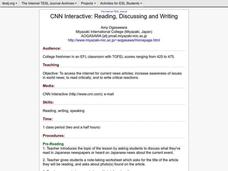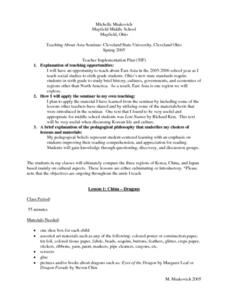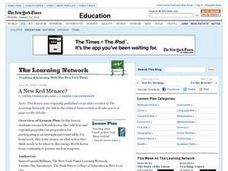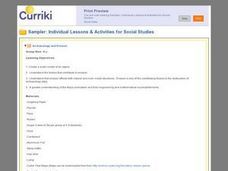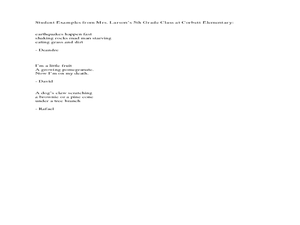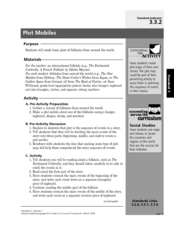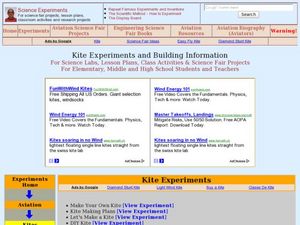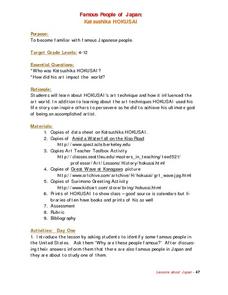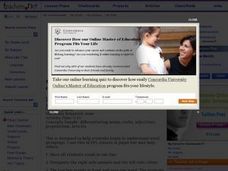Curated OER
CNN Interactive: Reading, Discussing and Writing
Students access the internet for current news articles; increase awareness of issues in world news; to read critically; and to write critical reactions.
Curated OER
Love It or Leave It?
Students identify flags by country, then research the symbolism and history of those flags in preparation for writing and delivering oral presentations. For homework, they write essays reflecting on the relationship between flags,...
Curated OER
China - Dragons
Students compare cultural practices, products, and perspectives to understand commonality and diversity among cultures. They analyze examples of interactions between cultural groups and explain factors that contribute to cooperation...
Curated OER
Order of Operations
Fourth graders develop an understanding of the order of operations by relating to putting on a sock and shoe. In this order of operations lesson, 4th graders a mnemonic device to complete math examples. Students can communicate the...
Curated OER
Late 19th Century U.S. Foreign Policy
Eleventh graders discover that many of the issues the United States faces today elicit the same type of political, philosophical and moral debate that has divided the country in the past.
Curated OER
A New Red Menace?
Students research and analyze the current political situation of North Korea. They read and discuss an article, conduct research, participate in a simulation of an international round table, and write a response essay.
Curated OER
Bridging History and Technology
Students study the history and importance of the Triborough Bridge in New York City, and then research different bridges and prepare presentations about them. They, in groups, research a bridge and prepare a poster about it.
Curated OER
World in the Balance
Students explore population growth. They calculate how long it takes a country's population to double in size and to investigate factors affecting growth rate. In addition, they list of factors they think might affect growth rate
Peace Corps
Cuisine and Etiquette
Learners identify the main food in the different cultures they have examined. In groups, they compare and contrast their expected table manners to the ones in Sierra Leone, Uganda and Zambia. Using this list of behaviors, they identify...
Curated OER
Archaeology and Erosion
Sixth graders study how erosion affects archaeology sites. In this investigative lesson, 6th graders construct a model of a pyramid using sugar cubes. They will investigate in groups how water, wind, and sunlight affects their model...
Curated OER
Take a Breath, Steal Some Time
Students explore the art of haiku's by listening to, modeling and creating them. In this haiku poetry lesson, students choose an object to focus their haiku on. After hearing a brief history of the haiku; students make...
Curated OER
Plot Mobiles
Students read folktales and identify the plot of the story by making a mobile. In this inventive and colorful lesson, students listen to a variety of famous folktales, and practice identifying the plot. Then, they work together to create...
Curated OER
Magnetic Levitation
Students conduct a series of experiments on magnetic levitation. In this physics instructional activity, students discover how Maglev trains operate. They explain how magnetism make even simple objects levitate.
Curated OER
Earthquake Experiments
Students discuss the effects of earthquakes. In this earth science lesson, students create earthquake models and earthquake-proof buildings. They construct their own seismograph.
Curated OER
Kite Experiments and Building Information
Students build their own kite following certain procedures. In this physics instructional activity, students explain the aerodynamics concepts involved in flying kites. They trace the development of aviation.
Curated OER
The Concept of Wa I
Twelfth graders compare how disputes are resolved in Japan and the United States. They read the case, state the facts of the case, and identify the issues involved. They determine that preserving harmonious relationships is more...
Curated OER
Katsushika HOKUSAI
Students identify some famous people in the United States and why these people are famous. Students identify and discuss famous people in Japan. Students use internet websites in bibliography if computer is available to learn more about...
Curated OER
Making A Karuta Game
Students explore the culture of Japan be creating a traditional Japanese game called Karuta. They conduct research in order to find the rules for the game and to make cultural connections. The content of the game is modified according to...
Curated OER
Contemporary Japanese Relief Printing
STudents identify and interpret relief printing and that the art of printing is not only an ancient art in Japan but a contemporary one as well. Students identify who Fumio Fujita is and his artworks.
Curated OER
Moral and Ethical Beliefs: Proverbs
Students compare and contrast the cultures of Japan and the United States. In groups, they are given a proverb from each country and note the similiarties in their teachings. They complete a worksheet and share their findings with the...
Curated OER
World War Ii - Japanese American Internment
Ninth graders determine that nationality is not defined by race, especially in the United States. They group into teacher created dyads with eight pictures. Four pictures are of American citizens (multiracial representations), and...
Curated OER
Social Studies: Bombing of Hiroshima
Students read a first person account of the bombing of Hiroshima written by a Japanese physician. By reading Michihiko Hachiya's journal, they discover the fatalities caused by the bomb itself and later by radiation poisoning. To...
Curated OER
The Tale of the Mandarin Ducks
High schoolers are introduced to the time of the samurai warriors using the guided reading of "The Tale of the Mandarin Ducks". The teacher reads the story to the students and they make connections from the text about the history of the...
Curated OER
Line Jumping: Differenciation of Words
Students participate in a line jumping game in which they have to decide what part of speech the word is. They can practice the difference between adjectives and nouns or nouns and verbs.
